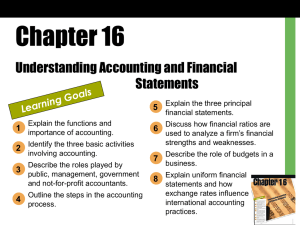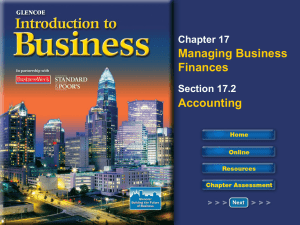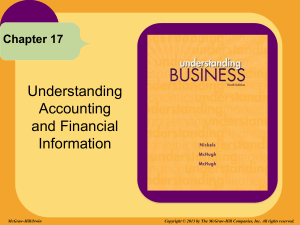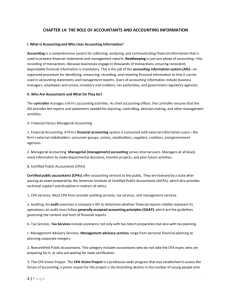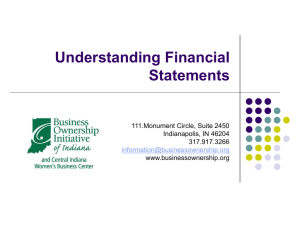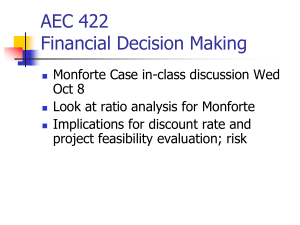Accounting
advertisement
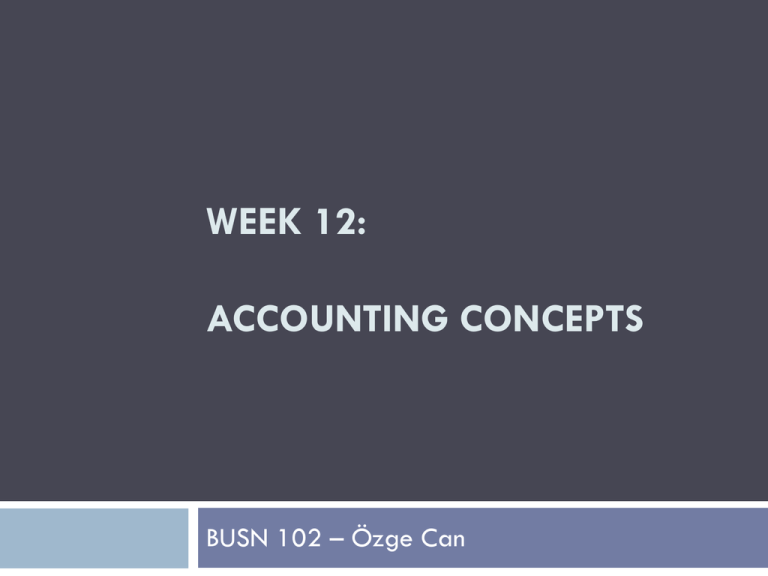
WEEK 12: ACCOUNTING CONCEPTS BUSN 102 – Özge Can Understanding Accounting 17-2 Accounting Measuring, interpreting, and communicating financial information to support internal and external decision-making Cost accounting, tax accounting, financial analysis, forensic accounting Understanding Accounting 17-3 Financial Accounting: The area of accounting concerned with preparing financial information for users outside the organization Management Accounting: The area of accounting concerned with preparing data for use by managers within the organization What Accountants Do? 4 Record economic activities (bookkeeping) Prepare financial statements Analyze and interpret financial information Prpepare financial forecasts and budgets Prepare tax returns Private Accountants 17-5 Private Accountants In-house accountants employed by organizations and businesses other than a public accounting firm (corporate accountants) Certified Public Accountants (CPAs) Professionally licensed accountants who meet certain requirements for education and experience and who pass a comprehensive examination Public Accountants 17-6 Public Accountants Professionals who provide accounting services to other businesses and individuals for a fee Audit Formal evaluation of the fairness and reliability of a client’s financial statements Typical Finance Department: 17-7 The Rules of Accounting 17-8 GAAP (Generally Accepted Accounting Practices) Standards and practices used by publicly held corporations in the United States and a few other countries in the preparation of financial statements; on course to converge with IFRS The Rules of Accounting 17-9 External Auditors Independent accounting firms that provide auditing services for public companies International Financial Reporting Standards (IFRS) Accounting standards and practices used in many countries outside the United States Fundamental Accounting Concepts 17-10 Assets: Any things of value owned or leased by a business Liabilities: Claims against a firm’s assets by creditors Owners’ Equity: The portion of a company’s assets that belongs to the owners after obligations to all creditors have been met Fundamental Accounting Concepts 17-11 Accounting Equation The basic accounting equation, stating that assets equal liabilities plus owners’ equity Example: 12 A company has the following assets: (1) Fixed assets worth $30,000 and (2) investments worth $6,000. The company's total liabilities amount to $25,000. What is the owner's equity of this company? Fundamental Accounting Concepts 17-13 Double-Entry Bookkeeping A method of recording financial transactions that requires a debit entry and credit entry for each transaction to ensure that the accounting equation is always kept in balance Fundamental Accounting Concepts 17-14 Matching Principle The fundamental principle requiring that expenses incurred in producing revenue be deducted from the revenues they generate during an accounting period Two Bases of Accounting: 17-15 Accrual Basis An accounting method in which revenue is recorded when a sale is made and an expense is recorded when it is incurred Cash Basis An accounting method in which revenue is recorded when payment is received and an expense is recorded when cash is paid 17-16 Depreciation An accounting procedure for systematically spreading the cost of a tangible asset over its estimated useful life The Accounting Cycle: 17-17 1. 2. 3. 4. 5. 6. 7. 8. Perform transactions Analyze and record transactions in a journal Post journal entries to the ledger Prepare a trial balance Make adjusting entries, as needed Prepare an adjusted trial balance Prepare financial statements Close the books for the accounting period Three Financial Statements: 17-18 Balance Sheet Income Statement Statement of Cash Flows Balance Sheet 17-19 Balance Sheet A statement of a firm’s financial position on a particular date; also known as a statement of financial position Balance Sheet 17-20 Current Assets Cash and items that can be turned into cash within one year Fixed Assets Assets retained for long-term use, such as land, buildings, machinery, and equipment Property, plant, and equipment Balance Sheet 17-21 Current Liabilities Obligations that must be met within a year Long-Term Liabilities Obligations that fall due more than a year from the date of the balance sheet Balance Sheet 17-22 Retained Earnings The portion of shareholders’ equity earned by the company but not distributed to its owners in the form of dividends Income Statement 17-23 Income Statement A financial record of a company’s revenues, expenses, and profits over a given period of time Profit and loss statement Income Statement 17-24 Expenses Costs created in the process of generating revenues Net Income Profit earned or loss incurred by a firm, determined by subtracting expenses from revenues Income Statement 17-25 Cost of Goods Sold The cost of producing or acquiring a company’s products for sale during a given period Gross Profit (Gross Margin) The amount remaining when the cost of goods sold is deducted from net sales Income Statement 17-26 Operating Expenses All costs of operation that are not included under cost of goods sold General expenses - selling expenses EBITDA Earnings before interest, taxes, depreciation, and amortization Statement of Cash Flows 17-27 Statement of Cash Flows A statement of a firm’s cash receipts and cash payments that presents information on its sources and uses of cash Analyzing Financial Staments 28 Trend analysis Ratio analysis Types of financial ratios: Profitability ratios Liquidity ratios Activity ratios Leverage (debt) ratios Profitability Ratios 17-29 Return on Sales The ratio between net income after taxes and net sales Profit margin Return on Equity The ratio between net income after taxes and total owners’ equity Profitability Ratios 17-30 Earnings per Share A measure of a firm’s profitability for each share of outstanding stock, calculated by dividing net income after taxes by the average number of shares of common stock outstanding Liquidity Ratios 17-31 Working Capital Current assets minus current liabilities Current Ratio A measure of a firm’s short-term liquidity, calculated by dividing current assets by current liabilities Liquidity Ratios 17-32 Quick Ratio A measure of a firm’s short-term liquidity, calculated by adding cash, marketable securities, and receivables, then dividing that sum by current liabilities Acid-test ratio Activity Ratios 17-33 Inventory Turnover Ratio A measure of the time a company takes to turn its inventory into sales, calculated by dividing cost of goods sold by the average value of inventory for a period Activity Ratios 17-34 Accounts Receivable Turnover Ratio A measure of the time a company takes to turn its accounts receivable into cash, calculated by dividing sales by the average value of accounts receivable for a period Leverage (Debt) Ratios 17-35 Debt-to-Equity Ratio A measure of the extent to which a business is financed by debt as opposed to invested capital, calculated by dividing the company’s total liabilities by owners’ equity Debt-to-Assets Ratio A measure of a firm’s ability to carry long-term debt, calculated by dividing total liabilities by total assets Assignment #3 (Due: Next Week) 36 Written Group Assignment Research online and find 1) the balance sheet (“bilanço”) and 2) income statement (“gelir tablosu”) of a Turkish or foreign/international company for the year 2012. Examine these two statements carefully in order to understand the financial situation of the company. ==== > Assignment #3 (Due: Next Week) 37 After providing a copy of the two financial statements in the paper, answer the following questions: 1. What are the amount of assets, liabilities and stockholders’ equity of the company? 2. Did the company show a profit in 2012? What is the sales revenue? What are their largest cost and expense items? 3. Overall, do you think this company financialy doing good? How do you understand this?

